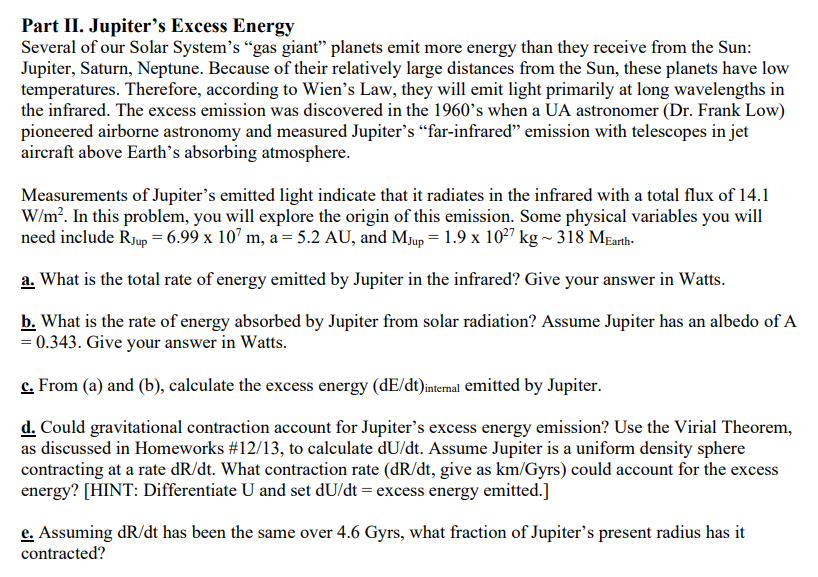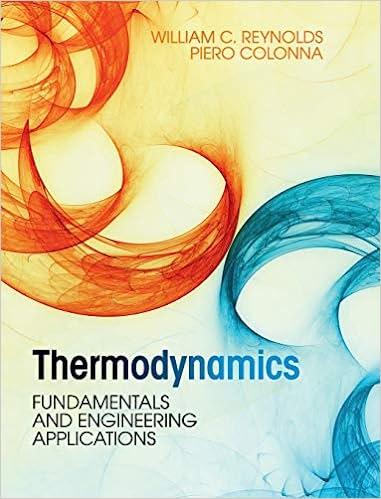
Part II. Jupiter's Excess Energy Several of our Solar System's "gas giant planets emit more energy than they receive from the Sun: Jupiter, Saturn, Neptune. Because of their relatively large distances from the Sun, these planets have low temperatures. Therefore, according to Wien's Law, they will emit light primarily at long wavelengths in the infrared. The excess emission was discovered in the 1960's when a UA astronomer (Dr. Frank Low) pioneered airborne astronomy and measured Jupiter's far-infrared emission with telescopes in jet aircraft above Earth's absorbing atmosphere. Measurements of Jupiter's emitted light indicate that it radiates in the infrared with a total flux of 14.1 W/m. In this problem, you will explore the origin of this emission. Some physical variables you will need include Rjup = 6.99 x 10 m, a= 5.2 AU, and Mjup = 1.9 x 107 kg 318 MEarth- a. What is the total rate of energy emitted by Jupiter in the infrared? Give your answer in Watts. b. What is the rate of energy absorbed by Jupiter from solar radiation? Assume Jupiter has an albedo of A = 0.343. Give your answer in Watts. c. From (a) and (b), calculate the excess energy (dE/dt)internal emitted by Jupiter. d. Could gravitational contraction account for Jupiter's excess energy emission? Use the Virial Theorem, as discussed in Homeworks #12/13, to calculate dU/dt. Assume Jupiter is a uniform density sphere contracting at a rate dR/dt. What contraction rate (dR/dt, give as km/Gyrs) could account for the excess energy? [HINT: Differentiate U and set dU/dt = excess energy emitted.] e. Assuming dR/dt has been the same over 4.6 Gyrs, what fraction of Jupiter's present radius has it contracted? Part II. Jupiter's Excess Energy Several of our Solar System's "gas giant planets emit more energy than they receive from the Sun: Jupiter, Saturn, Neptune. Because of their relatively large distances from the Sun, these planets have low temperatures. Therefore, according to Wien's Law, they will emit light primarily at long wavelengths in the infrared. The excess emission was discovered in the 1960's when a UA astronomer (Dr. Frank Low) pioneered airborne astronomy and measured Jupiter's far-infrared emission with telescopes in jet aircraft above Earth's absorbing atmosphere. Measurements of Jupiter's emitted light indicate that it radiates in the infrared with a total flux of 14.1 W/m. In this problem, you will explore the origin of this emission. Some physical variables you will need include Rjup = 6.99 x 10 m, a= 5.2 AU, and Mjup = 1.9 x 107 kg 318 MEarth- a. What is the total rate of energy emitted by Jupiter in the infrared? Give your answer in Watts. b. What is the rate of energy absorbed by Jupiter from solar radiation? Assume Jupiter has an albedo of A = 0.343. Give your answer in Watts. c. From (a) and (b), calculate the excess energy (dE/dt)internal emitted by Jupiter. d. Could gravitational contraction account for Jupiter's excess energy emission? Use the Virial Theorem, as discussed in Homeworks #12/13, to calculate dU/dt. Assume Jupiter is a uniform density sphere contracting at a rate dR/dt. What contraction rate (dR/dt, give as km/Gyrs) could account for the excess energy? [HINT: Differentiate U and set dU/dt = excess energy emitted.] e. Assuming dR/dt has been the same over 4.6 Gyrs, what fraction of Jupiter's present radius has it contracted







